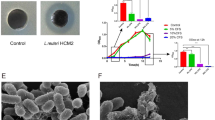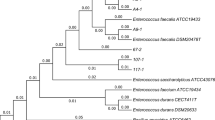Abstract
Previously, we produced two groups of gnotobiotic mice, GB-3 and GB-4, which showed different responses to Escherichia coli O157:H7 challenge. E. coli O157:H7 was eliminated from GB-3, whereas GB-4 became carriers. In this study, we analysed the mechanisms of E. coli O157:H7 elimination using GB-3 and GB-4. When GB-3 and GB-4 mice were challenged with E. coli O157:H7, the E. coli O157:H7 population was reduced in the caecum of GB-3 when compared to that in the GB-4 caecum, although the numbers of E. coli O157:H7 in the small intestine were not significantly different between these two groups of gnotobiotic mice. The lag time of E. coli O157:H7 growth in a 50% GB-3 caecal suspension increased when compared to that in a GB-4 caecal suspension. Acetate and lactate were detected in the GB-3 caecal contents, and acetate and propionate in those from GB-4. Although E. coli O157:H7 growth was not suppressed when it was cultured in anaerobic broth supplemented with these organic acids, the motility of E. coli O157:H7 was suppressed when it was cultured on semi-solid agar supplemented with the combination of acetate and lactate. These results indicate that the organic acid profile in the caecum is an important factor related to the elimination of E. coli O157:H7 from the intestine.




Similar content being viewed by others
Abbreviations
- BFA:
-
Baby-flora-associated
- CFU:
-
Colony forming units
- GF:
-
Germfree
- STEC:
-
Shiga toxin producing Escherichia coli
- TSB:
-
Trypticase soy broth without dextrose
References
Asahara T, Shimizu K, Nomoto K, Hamabata T, Ozawa A, Takeda Y (2004) Probiotic bifidobacteria protect mice from lethal infection with shiga toxin-producing Escherichia coli O157:H7. Infect Immun 72:2240–2247
Benno Y, Sawada K, Mitsuoka T (1984) The intestinal microflora of infants: composition of fecal flora in breast-fed and bottle-fed infants. Microbiol Immunol 28:975–986
Carman RJ, Simon MA, Fernández H, Miller MA, Bartholomew MJ (2004) Ciprofloxacin at low levels disrupts colonization resistance of human faecal microflora growing in chemostats. Reg Toxicol Pharmacol 40:319–326
Claud EC, Walker WA (2001) Hypothesis: inappropriate colonization of the premature intestine can cause neonatal necrotizing enterocolitis. FASEB J 15:1398–1403
Dai D, Walker WA (1999) Protective nutrients and bacterial colonization in the immature human gut. Adv Pediatr 46:353–382
Donskey CJ, Hume ME, Callaway TR, Das SM, Hoyen CK, Rice LB (2001) Inhibition of vancomycin-resistant enterococci by an in vitro continuous-flow competitive exclusion culture containing human stool flora. J Infect Dis 184:1624–1627
Edwards CA, Parrett AM, Balmer SE, Wharton BA (1994) Faecal short chain fatty acids in breast-fed and formula-fed babies. Acta Paediatr 83:459–462
Fenchel T (2002) Microbial behavior in a heterogeneous world. Science 296:1068–1071
Freter R, Brickner H, Fekete J, Vickerman MM, Carey KE (1983) Survival and implantation of Escherichia coli in the intestinal tract. Infect Immun 39:686–703
Girón JA, Torres AG, Freer E, Kaper JB (2002) The flagella of enteropathogenic Escherichia coli mediate adherence to epithelial cells. Mol Microiol 44:361–379
Guiot HFL (1982) Role of competition for substrate in bacterial antagonism in the gut. Infect Immun 38:887–892
Howie PW, Forsyth JS, Ogston SA, Clark A, Florey CV (1990) Protective effect of breast feeding against infection. BMJ 300:11–16
Itoh K, Freter R (1989) Control of Escherichia coli populations by a combination of indigenous clostridia and lactobacilli in gnotobiotic mice and continuous-flow cultures. Infect Immun 57:559–565
Josenhans C, Suerbaum S (2002) The role of motility as a virulence factor in bacteria. Int J Med Microbiol 291:605–614
Momose Y, Hirayama K, Itoh K (2005) Antagonism of intestinal bacteria isolated from human infants against Escherichia coli O157:H7 infection in gnotobiotic mice. Microbial Ecol Health Dis 17:9–14
Mortensen FV, Møller JK, Hessov IB (1999) Effects of short-chain fatty acids on in vitro bacterial growth of Bacteroides fragilis and Escherichia coli. APMIS 107:240–244
Narushima S, Itoh K, Kuruma K, Uchida K (1999) Cecal bile acid compositions in gnotobiotic mice associated with human intestinal bacteria with the ability to transform bile acids in vitro. Microbial Ecol Health Dis 11:55–60
Ogawa K, Ben RA, Pons S, de Paolo MIL, Fernándes LB (1992) Volatile fatty acids, lactic acid, and pH in the stools of breast-fed and bottle-fed infants. J Pediatr Gastroenterol Nutr 15:248–252
Ogawa M, Shimizu K, Nomoto K, Tanaka R, Hamabata T, Yamasaki S, Takeda T, Takeda Y (2001) Inhibition of in vitro growth of shiga toxin-producing Escherichia coli O157:H7 by probiotic Lactobacillus strains due to production of lactic acid. Int J Food Microbiol 68:135–140
Ohmomo S, Tanaka O, Kitamoto H (1993) Analysis of organic acids in silage by high-performance liquid chromatography. Bull Natl Grassl Inst 48:51–56
Ottemann KM, Miller JF (1997) Roles for motility in bacterial-host interactions. Mol Microbiol 24:1109–1117
Polen T, Rittmann D, Wendisch VF, Sahm H (2003) DNA microarray analyses of the long-term adaptive response of Escherichia coli to acetate and propionate. Appl Environ Microbiol 69:1759–1774
Postnova T, Gómez-Duarte OG, Richardson K (1996) Motility mutants of Vibrio cholerae O1 have reduced adherence in vitro to human small intestinal epithelial cells as demonstrated by ELISA. Microbiol 142:2767–2776
Que JU, Casey SW, Hentges DJ (1986) Factors responsible for increased susceptibility of mice to intestinal colonization after treatment with streptomycin. Infect Immun 53:116–123
Savage DC (1987) Microorganisms associated with epithelial surfaces and stability of the indigenous gastrointestinal microflora. Die Nahrung 31:383–395
Shin R, Suzuki M, Morishita Y (2002) Influence of intestinal anaerobes and organic acids on the growth of enterohaemorrhagic Escherichia coli O157:H7. J Med Microbiol 51:201–206
Siegler RL (1994) Spectrum of extrarenal involvement in postdiarrheal hemolytic-uremic syndrome. J Pediatr 125:511–518
Silva SH, Vieira EC, Dias RS, Nicoli JR (2001) Antagonism against Vibrio cholerae by diffusible substances produced by bacterial components of the human faecal microbiota. J Med Microbiol 50:161–164
Snoeyenbos GH (1979) Role of native intestinal microflora in protection against pathogens. Proc Annu Meet US Anim Health Assoc 83:388–393
Swidsinski A, Loening-Baucke V, Theissig F, Engelhardt H, Bengmark S, Koch S, Lochs H, Dörffel Y (2007) Comparative study of the intestinal mucus barrier in normal and inflamed colon. Gut 56:343–350
Ushijima T, Seto A (1991) Selected faecal bacteria and nutrients essential for antagonism of Salmonella typhimurium in anaerobic continuous flow cultures. J Med Microbiol 35:111–117
Yamamoto-Osaki T, Kamiya S, Sawamura S, Kai M, Ozawa A (1994) Growth inhibition of Clostridium difficile by intestinal flora of infant faeces in continuous flow culture. J Med Microbiol 40:179–187
Acknowledgements
We wish to thank Ms. Masako Fujiwara for technical support in studies using germfree mice. This work was supported by a grant from the Yakult Bio-Science Foundation.
Author information
Authors and Affiliations
Corresponding author
Rights and permissions
About this article
Cite this article
Momose, Y., Hirayama, K. & Itoh, K. Effect of organic acids on inhibition of Escherichia coli O157:H7 colonization in gnotobiotic mice associated with infant intestinal microbiota. Antonie van Leeuwenhoek 93, 141–149 (2008). https://doi.org/10.1007/s10482-007-9188-9
Received:
Accepted:
Published:
Issue Date:
DOI: https://doi.org/10.1007/s10482-007-9188-9




